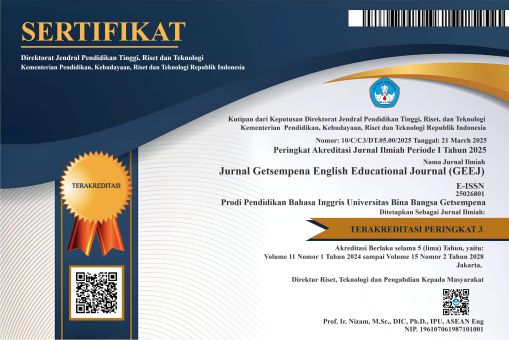THE CONSTRAINTS FACED BY EFL LECTURERS TO THE IMPLEMENTATION OF ONLINE LEARNING
Abstract
The increasing demand for online learning learning has led to its widespread adoption across Indonesia, influencing all levels of education. This sudden shift has pushed educators to quickly adapt to digital technologies, primarily relying on internet-based platforms and email communication. The rapid transition to online learning has created opportunities for pedagogical innovation but also introduced significant challenges, particularly in English language education. This study investigates the obstacles encountered by English as a Foreign Language (EFL) lecturers in implementing online learning. Using a quantitative research approach, data were collected from eight EFL lecturers teaching at both governmental and private universities in Aceh, Indonesia. The data were obtained through online questionnaires, providing insights into the various constraints experienced by these lecturers. The primary challenges reported include a lack of meaningful interaction between lecturers and students, suboptimal learning and evaluation processes, and difficulties in teaching skills-based material online. Other issues highlighted were students' limited understanding of the content, inconsistent internet connection, student disengagement from assignments, lecturer fatigue, and inadequate access to learning resources and support tools. This research provides a comprehensive overview of the barriers faced by EFL lecturers in transitioning to online teaching, offering valuable insights for improving the design and delivery of online education in similar contexts.
References
Al-Maroof, R. S., Alnazzawi, N., Akour, I. A., Ayoubi, K., Alhumaid, K., AlAhbabi, N. M., Alnnaimi, M., Thabit, S., Alfaisal, R., & Aburayya, A. (2021). The Effectiveness of Online Platforms after the Pandemic: Will Face-to-Face Classes Affect Students’ Perception of Their Behavioural Intention (BIU) to Use Online Platforms? Informatics, 8(4), 83. https://doi.org/10.3390/informatics8040083
Alqurashi, F. (2011). Short communications. eLearning in EFL: Problems and solutions. Psychology of Language and Communication, 15(1), 107–116. https://doi.org/10.2478/v10057-011-0006-0
Atmojo, A. E. P., & Nugroho, A. (2020). EFL Classes Must Go Online! Teaching Activities and Challenges during COVID-19 Pandemic in Indonesia. Register Journal, 13(1), 49–76. https://doi.org/10.18326/rgt.v13i1.49-76
Bezhovski, Z., & Poorani, S. (2016). The Evolution of E-Learning and New Trends. Information and Knowledge Management, 6 (3), 50–57
Creswell, J. W. (2014). Research design: Qualitative, quantitative, and mixed methods approaches (4th ed.). Sage Publications.
Cronje, J. C. (2020). Towards a new definition of blended learning. Electronic Journal of E-Learning, 18(2), 114–135. https://doi.org/10.34190/EJEL.20.18.2.001
Dhawan, S. (2020). Online learning: A panacea in the time of COVID-19 crisis. Journal of Educational Technology Systems, 49(1), 5-22. https://doi.org/10.1177/0047239520934018
Gultom, S., Endriani, D., & Harahap, A. S. (2022). Less Emotion but More Fatigue: Social-Emotional Learning (SEL) Competencies, and Compassion Fatigue among Educators during the COVID-19 Pandemic. Kinestetik : Jurnal Ilmiah Pendidikan Jasmani, 6(1), 146–158. https://doi.org/10.33369/jk.v6i1.21034
Horton, W. (2011). E-Learning by Design. John Wiley & Sons.
Junus, K., Santoso, H. B., Putra, P. O. H., Gandhi, A., & Siswantining, T. (2021). Lecturer readiness for online classes during the pandemic: A survey research. Education Sciences, 11(3). https://doi.org/10.3390/educsci11030139
Kattoua, T., Al-Lozi, M., & Alrowwad, A. (2016). A review of literature on E-learning systems in higher education. International Journal of Business Management & Economic Research, 7(5), 754–762
Kothari, C. (2004). Research methodology: Methods and techniques
Makarim, N. (2020). Nadiem Jelaskan Makna Pembelajaran Daring. Retrieved from https://republika.co.id/ berita/q7p9wr409/nadiem-jelaskan-makna-pembelajaran-daring. Rabu 25 Mar 2020 01:36 WIB
Mulyani, Fidyati, Suryani, Suri, M., & Halimatussakdiah. (2021). University students’ perceptions through e-learning implementation during covid-19 pandemic: Positive or negative features dominate? Studies in English Language and Education, 8(1), 197–211. https://doi.org/10.24815/siele.v8i1.17628
Mutia, I., & Leonard. (2013). Kajian Penerapan E-Learning dalam Proses Pembelajaran di Perguruan Tinggi. Faktor Exacta, 6(4), 278–289. https://journal.lppmunindra.ac.id/index.php/Faktor_Exacta/article/view/239
Oludare Jethro, O., Moradeke Grace, A., & Kolawole Thomas, A. (2012). E-Learning and Its Effects on Teaching and Learning in a Global Age. International Journal of Academic Research in Business and Social Sciences, 2(1), 2222–6990
Pane, A., & Darwis, D.M. (2017) Belajar Dan Pembelajaran. FITRAH:Jurnal Kajian Ilmu-Ilmu Keislaman, 3(2), 333. https://doi.org/10.24952/fitrah.v3i2.945
Ramane, D. V. (2021). The impact of online learning on learners’ education and health. The Online Journal of Distance Education and E-Learning, 9(2), 303–309. www.tojdel.net
Republik Indonesia, Undang-undang Republik Indonesia Nomor 20 tahun 2003 tentang Sistem Pendidikan Nasional. Retrieved from https://jdih.setkab.go.id/PUUdoc/7308/UU0202003.htm
Salam, U., Wahdini, W., Surmiyati, S., Rezeki, Y. S., Riyanti, D., & Suthathothon, P. (2023). Teachers’ challenges and strategies in using digital media in teaching English. Journal of English Language Teaching Innovations and Materials (Jeltim), 5(1), 49. https://doi.org/10.26418/jeltim.v5i1.63204
Sari, D. K., & Darlis, V. (2021). The Effectiveness of Blended Learning: The Impact of Student’s Characteristics and Digital Literacy on Student Performance. Proceedings of the 3rd International Conference on Educational Development and Quality Assurance (ICED-QA 2020), 561-566. Atlantis Press. https://doi.org/10.2991/assehr.k.210202.097
Sekti, R. P., Juwariyah, A., & Trisakti. (2020). Online Learning During the Covid-19 Pandemic and Its Physical Impact on Lecturers. 491(Ijcah), 671–677. https://doi.org/10.2991/assehr.k.201201.115
Singh, K. K. A. H., & Yunus, M. M. (2021). Using E-Learning in English Language Teaching: A Systematic Review. International Journal of Academic Research in Progressive Education and Development, 10(1), 51–62. https://doi.org/10.6007/ijarped/v10-i1/8338
Sukman, K., & Mhunkongdee, T. (2021). Thai EFL Learners’ Voices on Learning English Online during the COVID-19 Pandemic. SSRN Electronic Journal, April, 0–11. https://doi.org/10.2139/ssrn.3824069
Sugiyono, D. (2013). Metode Penelitian Pendidikan Pendekatan Kuantitatif, kualitatif, dan R&D [Educational Research Methods Quantitative, qualitative, and R&D approaches]. Alfabeta
White, C. (2018). Moving from the past and the present to the future of e-Learning. E-Learning Industry. https://elearningindustry.com/future-ofelearning-past-present
Widiyono, A. (2020). Efektifitas Perkuliahan Daring (Online) pada Mahasiswa PGSD di Saat Pandemi Covid 19. Jurnal Pendidikan, 8(2), 169–177. https://doi.org/10.36232/pendidikan.v8i2.458
Yimwilai, S. (2015). An integrated approach to teaching literature in an EFL classroom. English Language Teaching, 8(2). https://doi.org/10.5539/elt.v8n2p14
Zhao, J. H., Wu, P. Z., & Kong, J. (2020). Guidance for Online Learning Technologies and Platforms: Online Education During COVID-19 Pandemic. Shenzhen: UNESCO IITE.























